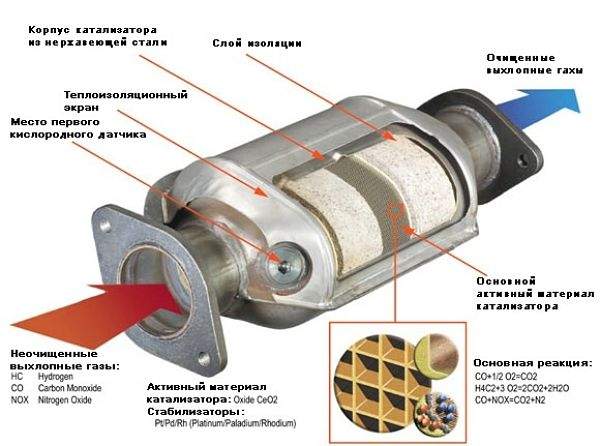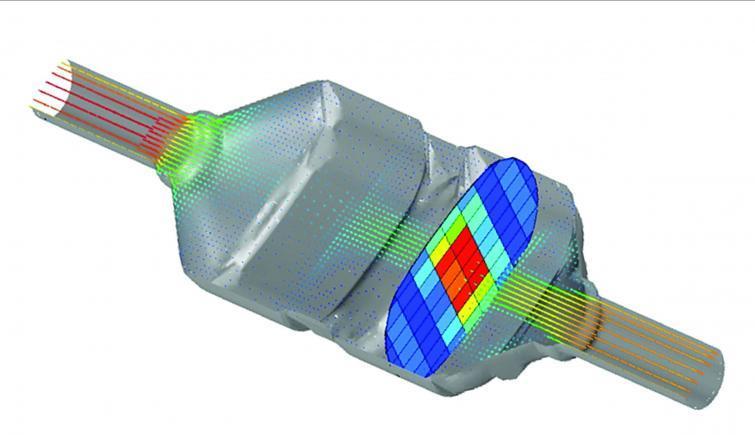
The catalyst in the car - how it works and what breaks in it. Guide
Content
 The catalyst in a car with a gasoline engine plays a very important role. This is not just an ordinary exhaust gas cleaner. The process of fuel combustion also depends on this element, i.e. proper engine operation and performance.
The catalyst in a car with a gasoline engine plays a very important role. This is not just an ordinary exhaust gas cleaner. The process of fuel combustion also depends on this element, i.e. proper engine operation and performance.

Automotive catalyst is a colloquial term for a catalytic converter, which is an element of the exhaust system, and its task is to reduce the amount of harmful compounds in the exhaust gases. Catalysts have been used for many years. Their presence in the exhaust system is regulated by regulations, because each car must comply with certain standards for the purity of exhaust gases. The newer they are, the stricter they are.
Some time ago we started using DPFs which act as catalysts in diesel vehicles. Now it's time for catalytic converters in gasoline engines..
See also: Modern diesel engine - is it necessary and how to remove a particulate filter from it. Guide
The catalyst in the car - the principle of operation
Outwardly, the catalyst resembles a muffler in the exhaust system (and is also part of this system). It is a tin can with many honeycomb channels coated with the appropriate elements, most often platinum, but also rhodium and palladium. These are precious metals, which is why there are cases of theft of catalysts.
The action of these compounds is aimed at reducing the content of toxic components in exhaust gases. This occurs as a result of entering into a chemical reaction with exhaust gases.
Depending on the material used for manufacturing, we distinguish between two types of catalysts: ceramic catalysts (with a ceramic block) and metal catalysts (with a metal block).
See also: Thieves prefer spare parts to cars, now they are hunting for catalysts
In older types of cars, the catalyst was located on the exhaust pipe under the floor of the car. In newer models, the catalysts are already in the exhaust manifold. This is due to the need to comply with the more stringent emission standards applicable to new vehicles. The catalyst arranged in this way heats up faster and therefore works more efficiently.
Catalyst in an internal combustion engine - the most common malfunctions
Despite unfavorable operating conditions (large temperature difference, humidity, impact), catalysts are quite durable devices. Most stand up to 200 runs. km and even longer, although the quality of exhaust gas cleaning deteriorates in some catalysts (this can be found out, for example, during technical inspection).
However, some older types of ceramic catalysts are less resistant to mechanical wear. In such devices, the ceramic core wears out. This is most common in vehicles with LPG engines where the gas setting is not properly adjusted.
However, similar damage can also occur in a gasoline-powered vehicle.
- This happens when the ignition system fails. Then a situation may arise when the combustion of fuel occurs in the catalytic converter, and not in the cylinder, explains Slavomir Szymczewski, an auto mechanic from Słupsk.
A similar situation may arise when trying to start the engine on the so-called. towing, i.e. being towed by another vehicle or being pushed. In this case, there is a risk that a dose of fuel will fall on the catalyst and burn there, which will lead to a sharp increase in temperature.
The catalyst can also fail when, after a long drive (the engine reaches its optimum operating temperature), we drive into a deep puddle of water. Then the catalyst will cool too quickly, which may affect its subsequent operation.
This usually applies to ceramic catalysts. Metal catalysts are more durable (but also more expensive). In addition, they heat up faster than ceramic catalysts and therefore reach their optimum operating temperature faster.
Symptoms of a failed catalytic converter in a car
The main symptoms of a failed catalytic converter are a drop in engine power or noise from under the chassis.
- This is a characteristic sound of ringing or rattling, - explains Slavomir Shimchevsky.
A faulty catalytic converter tells us its fault by flashing the CHECK light on the dashboard (but it also informs us of other engine faults).
Some drivers fix this problem by cutting out the catalyst and inserting a piece of the exhaust pipe in its place. This decision does not comply with the regulations, since it violates the vehicle's approval and increases the permissible exhaust emissions. At the next inspection at the inspection station, the diagnostician, after analyzing the exhaust gases (and looking under the chassis), quickly realizes that the car is out of order, and will not stamp the inspection.
Read also Should I bet on a turbocharged gasoline engine? TSI, T-Jet, EcoBoost
In newer vehicles with an OBDII diagnostic connector, the removal of the catalytic converter causes engine malfunctions, as data from the catalyst is removed by a lambda probe (sometimes there are more of them).
– This sensor is responsible for the exact dosage of the mixture. If he does not have enough catalyst readings, he doses the injection incorrectly, and this, in turn, can lead to further failures, says the mechanic.
Elimination of failure of the catalyst
There are only two ways to fix a catalyst malfunction - replace the damaged one with a new one or regenerate it. Until recently, the prices of catalysts could significantly empty the car owner's pocket. Currently, there are already many substitutes on the market at lower prices.
The easiest situation to select a catalytic converter is when this device is mounted on an exhaust pipe running under the chassis. Then you can install a universal catalyst that is not designed for a specific car model (only engine power is important). The price of such a device varies between PLN 200-800.
“However, in more modern cars, the exhaust system is more complicated. It has several catalysts, including those located in the exhaust manifold. This makes it difficult to use a replacement, explains Slavomir Szymczewski.
In this case, the price of the catalyst can reach PLN 4000.
The solution may be to regenerate the catalyst. Usually the list price for such a service is half the price of a new product. The problem is the need to immobilize the car for several days, since regeneration is not an immediate service.
Read also Buy aluminum wheels - new or used? What size to choose? (VIDEO)
Some car owners prefer to use a used catalytic converter. In addition to the fact that the element may fail, the assembly of the spent catalyst is not allowed. By law, a spent catalyst is considered waste destined for disposal. But you can make money from it. We can sell a used, non-working catalyst and thus cover the cost of buying a new one, at least partially. There are many companies on the market that buy these components and extract precious metals from them.
Wojciech Frölichowski

